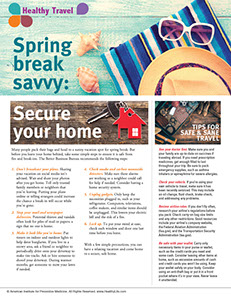SYMPTOM CHECKER
CONDITIONS
Male
Female
Child
Arm, Hand & Shoulder Concerns
Legs & Feet Concerns
Dental & Mouth Concerns
Ear & Nose
Eye Conditions
Head Conditions
Arm, Hand & Shoulder Concerns
Legs & Feet Concerns
Front
Back
Arm, Hand & Shoulder Concerns
Dental & Mouth Concerns
Ear & Nose
Eye Conditions
Head Conditions
Arm, Hand & Shoulder Concerns
Dental & Mouth Concerns
Ear & Nose
Eye Conditions
Head Conditions
Front
Back
Arm, Hand & Shoulder Concerns
Neck Links
Head & Neck Concerns
Arm, Hand & Shoulder Concerns
Neck Links
Head & Neck Concerns
Front
Back
Online Clinic
Wise Healthcare
Spring break savvy: Secure your home
Print on Demand
Many people pack their bags and head to a sunny vacation spot for spring break. But before you leave your home behind, take some simple steps to ensure it is safe from fire and break-ins. The Better Business Bureau recommends the following steps:
1. Don’t broadcast your plans. Sharing your vacation on social media isn't advised. Wait and share your photos after you get home. Tell only trusted family members or neighbors that you’re leaving. Putting your plans online or telling strangers could increase the chance a break-in will occur while you’re gone.
2. Stop your mail and newspaper deliveries. Potential thieves and vandals often look for piles of mail or papers; a sign that no one is home.
3. Make it look like you’re home. Put timers on indoor and outdoor lights to help deter burglaries. If you live in a snowy area, ask a friend or neighbor to periodically drive onto your driveway to make tire tracks. Ask or hire someone to shovel your driveway. During warmer months, get someone to mow your lawn if needed.
4. Check smoke and carbon monoxide detectors. Make sure these alarms are working so a neighbor could call for help if needed. Consider having a home security system.
5. Unplug gadgets. Only keep the necessities plugged in, such as your refrigerator. Computers, televisions, coffee makers, and similar items should be unplugged. This lowers your electric bill and the risk of a fire.
6. Lock up. To put your mind at ease, check each window and door one last time before you leave.
With a few simple precautions, you can have a relaxing vacation and come home to a secure, safe home.
Tips for safe & sane travel
See your doctor first. Make sure you and your family are up-to-date on vaccines if traveling abroad. If you need prescription medicines, get enough filled to last throughout your trip. Be sure to pack emergency supplies, such as asthma inhalers or epinephrine for severe allergies.
Check your vehicle. If you’re using your own vehicle to travel, make sure it has been recently serviced. This may include an oil change, fluid check, brake check, and addressing any problems.
Review airline rules. If you don’t fly often, research your airline’s regulations before you pack. Check carry-on bag size limits and any other restrictions. Good resources include your airline’s company website, the Federal Aviation Administration (faa.gov), and the Transportation Security Administration (tsa.gov).
Be safe with your wallet. Carry only necessary items in your purse or wallet, such as the credit cards you need and some cash. Consider leaving other items at home, such as excessive amounts of cash and credit cards you won’t be using. Keep your wallet safely on your body. Consider using an anti-theft bag or put it in a front pocket where it’s in your view. Never leave it unattended.
This website is not meant to substitute for expert medical advice or treatment. Follow your doctor’s or health care provider’s advice if it differs from what is given in this guide.
The American Institute for Preventive Medicine (AIPM) is not responsible for the availability or content of external sites, nor does AIPM endorse them. Also, it is the responsibility of the user to examine the copyright and licensing restrictions of external pages and to secure all necessary permission.
The content on this website is proprietary. You may not modify, copy, reproduce, republish, upload, post, transmit, or distribute, in any manner, the material on the website without the written permission of AIPM.
2021 © American Institute for Preventive Medicine - All Rights Reserved. Disclaimer | www.HealthyLife.com
















































